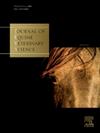呼吸物理疗法治疗马驹肺炎的疗效评价。
IF 1.6
3区 农林科学
Q2 VETERINARY SCIENCES
引用次数: 0
摘要
背景:肺炎是住院马驹的常见病,可引起气道炎症性分泌物的积累。在人类中,呼吸物理疗法通常被用作肺炎的补充治疗,其疗效各不相同,但迄今为止尚未对马驹的疗效进行评估。目的:本研究旨在评价呼吸物理治疗作为一种辅助治疗方法对小马肺炎的安全性和有效性。方法:选取44匹1月龄以下肺炎马驹。前瞻性干预组接受每日呼吸物理治疗(n=16)与历史对照组(n=28)进行比较,对照组由以前接受过肺炎治疗但未接受呼吸物理治疗的马驹组成。呼吸物理疗法包括旨在清除呼吸道分泌物的手工技术,如胸壁敲击和振动,以及体位引流。物理治疗干预前后评估的主要结果包括通过脉搏血氧仪测量和动脉血样本进行氧合评估、呼吸频率测定、呼吸音和呼吸类型评估以及不良反应评估。结果与结论:呼吸物理治疗作为马驹肺炎的辅助治疗是安全可行的。然而,除了干预后立即血氧饱和度可能升高(物理治疗前为95.1±4.5%,物理治疗后为96.1±3.8%,P=0.015)外,评估参数没有显著的临床改善。这一发现值得进一步调查。本文章由计算机程序翻译,如有差异,请以英文原文为准。
Evaluation of use of respiratory physiotherapy in treatment of young foals with pneumonia
Background
Pneumonia is a common condition in young, hospitalized foals, causing accumulation of inflammatory secretions to the airways. In humans, respiratory physiotherapy is commonly used as a supplementary treatment for pneumonia with varying results regarding its efficacy, but the efficacy in foals has not been assessed to date.
Aims
This study aimed to evaluate the safety and efficacy of respiratory physiotherapy as a supplementary therapy method for young foals with pneumonia.
Methods
A total of 44 foals with pneumonia aged under a month were used. The prospective intervention group receiving daily respiratory physiotherapy (n = 16) was compared with a historical control group (n = 28) consisting of foals previously treated for pneumonia without respiratory physiotherapy. Respiratory physiotherapy included manual techniques aiming to clear secretions from the airways such as chest wall percussion and vibration, and postural drainage. The main outcomes assessed before and after physiotherapy interventions included oxygenation evaluation via pulse oximetry measurements and arterial blood samples, determination of respiratory rate, assessment of breathing sounds and respiratory type, and assessment of adverse effects.
Results and conclusion
Respiratory physiotherapy as a supplementary therapy for foal pneumonia was found to be safe and feasible. However, it did not result in significant clinical improvements in the evaluated parameters, apart from a potential increase in oxygen saturation immediately after the intervention (95.1 ± 4.5 % before and 96.1 ± 3.8 % after physiotherapy, P = 0.015). This finding warrants further investigation.
求助全文
通过发布文献求助,成功后即可免费获取论文全文。
去求助
来源期刊

Journal of Equine Veterinary Science
农林科学-兽医学
CiteScore
2.70
自引率
7.70%
发文量
249
审稿时长
77 days
期刊介绍:
Journal of Equine Veterinary Science (JEVS) is an international publication designed for the practicing equine veterinarian, equine researcher, and other equine health care specialist. Published monthly, each issue of JEVS includes original research, reviews, case reports, short communications, and clinical techniques from leaders in the equine veterinary field, covering such topics as laminitis, reproduction, infectious disease, parasitology, behavior, podology, internal medicine, surgery and nutrition.
 求助内容:
求助内容: 应助结果提醒方式:
应助结果提醒方式:


